by Sara Bissen
I. 1947, A “Day of Reckoning”—The Central Planning Board of the City of Newark, New Jersey Addresses the Citizens of Newark[1]
Newark’s 1947 Master Plan, completed after a decade of population decline (1930–1940) and a decrease in real estate value, noted a “downward trend” that “must be arrested by undertaking privately financed large scale re-building projects in the deteriorated areas of Newark.”[2] “Rehabilitation and rebuilding” was the “surest way” to revert decline, and “rapid population increase” was “no longer considered a reliable measure of progress in a municipality.”[3]
In “A Proposed Housing Plan for Newark,” the 1947 Master Plan shows “Blighted Areas” marked to rehabilitate, and “Obsolete Areas” marked to clear and rebuild.[4] Of the “Day of Reckoning,” the Chairman, Peter A. Cavicchia from the Central Planning Board, wrote about the “ills” of the American city in which “Newark is no exception”—“ills” that came from “slums, blight, inadequate street pattern, over-crowding, obsolescence, population change, and high tax rate.”[5] The Central Planning Board decided that the U.S. cities of 1947 had become “plague centers for disease and cesspools of crime vice,” shamefully allowed to “come into being and exist” for so long.[6]
Because of such conditions, the City of Newark’s appointed Central Planning Board of 1943 surveyed technically Newark’s decline to serve as structure for its future development.[7] Such development noted by Chairman Cavicchia in referencing neighboring New York City’s urban improvements, such as sewage installation in preparation for purer water supply—were not initially done for “humanitarian purposes” but more so “because the city had grown so rapidly that open sewage in the streets had become an offense to the eyes and nostrils of the wealthier classes.”[8]
Norbert Elias, too, noted such a response in The Civilizing Process, specifically in his genesis of “Changes in the Behaviour of the Secular Upper Classes in the West,” where he observed differences in shame standards over time. In 1939, Elias noticed, since the transition into capitalism, “what first aroused and increased the distasteful feelings and restrictions was a transformation of human relationships and dependencies.”[9] Elias found that in societies of both greater interdependency and greater division of labor, things related to bodily function—such as in later years, things related to sewage and water—were standards not initially changed due to health and safety reasons, but because of the advanced threshold of repugnance from the upper classes.
Beyond “ills,” Newark’s 1947 Master Plan discussed “the curse of non-conforming uses, established prior to our Zoning Acts” as “still with us.”[10] The out-of-date practice of “property rights” in Newark were “still paramount,” and “zoning was weak and ineffective until the late 1920’s when [Newark’s] Courts finally ruled that Municipal and State Legislative Bodies had the right, under their police powers, to force individual property owners to conform to zoning restrictions, established for the common good of the community.”[11]
1947 Footnotes:
[1] Adopted July 10, 1947. Central Planning Board Newark, New Jersey. (1947). The master plan for the physical development of the City of Newark, N.J. (p. 1). City of Newark: Office of Planning, Zoning & Sustainability. Retrieved from https://planitnewark.files.wordpress.com/2011/01/1947newark.pdf
[2] Central Planning Board Newark, New Jersey. The master plan for the physical development of the City of Newark, N.J., op. cit. (p. 8).
[3] Central Planning Board Newark, New Jersey. The master plan for the physical development of the City of Newark, N.J., op. cit. (p. 14).
[4] Central Planning Board Newark, New Jersey. The master plan for the physical development of the City of Newark, N.J., op. cit. (p. 43, Plate 5).
[5] Central Planning Board Newark, New Jersey. The master plan for the physical development of the City of Newark, N.J., op. cit. (p. 2).
[6] Central Planning Board Newark, New Jersey. The master plan for the physical development of the City of Newark, N.J., op. cit. (p. 1).
[7] Central Planning Board Newark, New Jersey. The master plan for the physical development of the City of Newark, N.J., op. cit. (p. 2).
[8] Central Planning Board Newark, New Jersey. The master plan for the physical development of the City of Newark, N.J., op. cit. (p. 1).
[9] Elias, N. (2000 [1939]). The civilizing process: Sociogenetic and psychogenetic investigations. E. Dunning, J. Goudsblom, & S. Mennell (Eds.). (E. Jephcott, Trans.). (p. 134). Malden, MA: Blackwell.
[10] Central Planning Board Newark, New Jersey. The master plan for the physical development of the City of Newark, N.J., op. cit. (p. 1).
[11] Central Planning Board Newark, New Jersey. The master plan for the physical development of the City of Newark, N.J., op. cit. (p. 1).
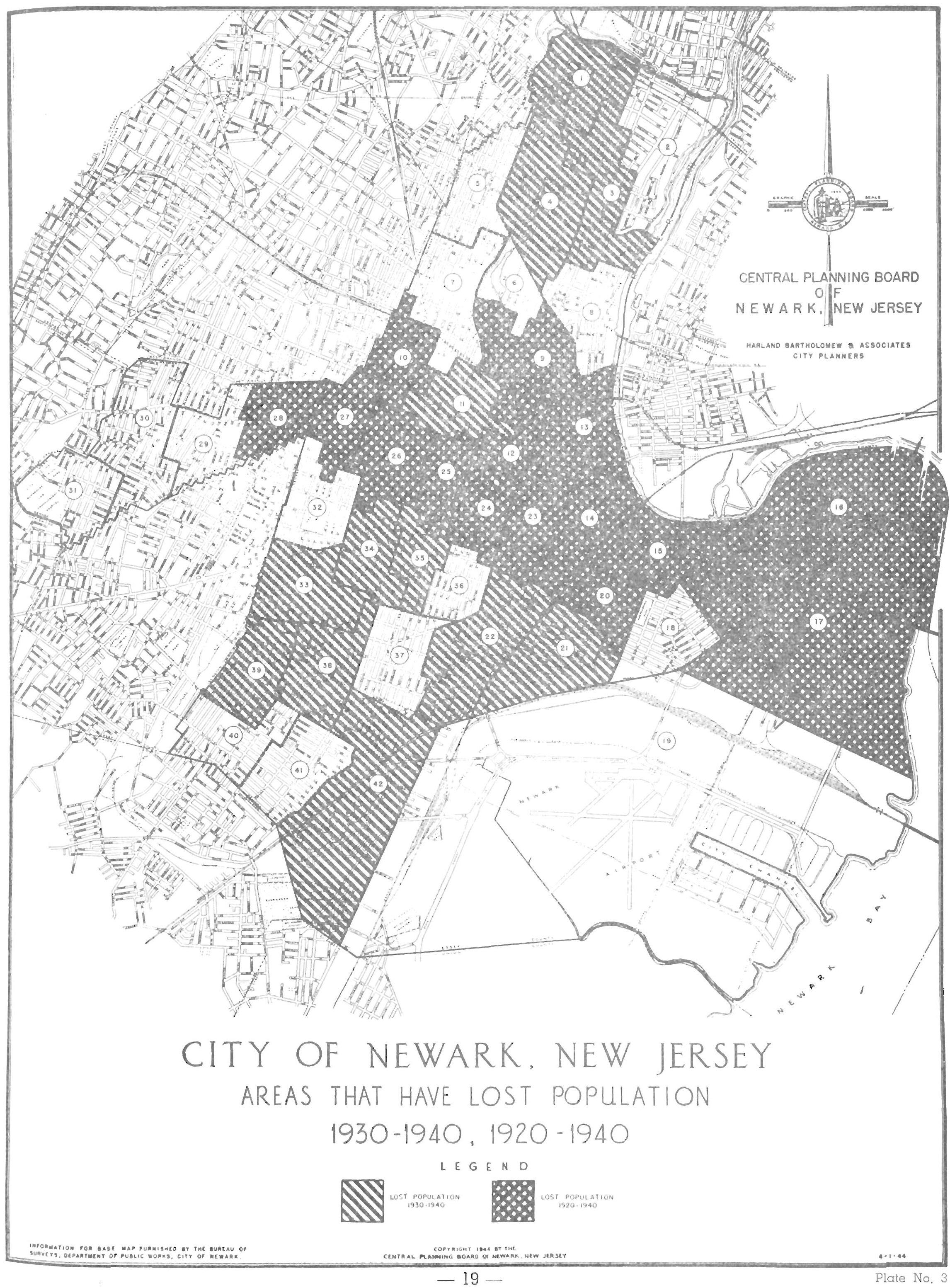
Central Planning Board Newark, New Jersey. (1947). The master plan for the physical development of the City of Newark, N.J. (“City of Newark, New Jersey: Areas That Have Lost Population 1930−1940, 1920−1940”) (p. 19, Plate No. 3). City of Newark: Office of Planning, Zoning & Sustainability. Retrieved from https://planitnewark.files.wordpress.com/2011/01/1947newark.pdf
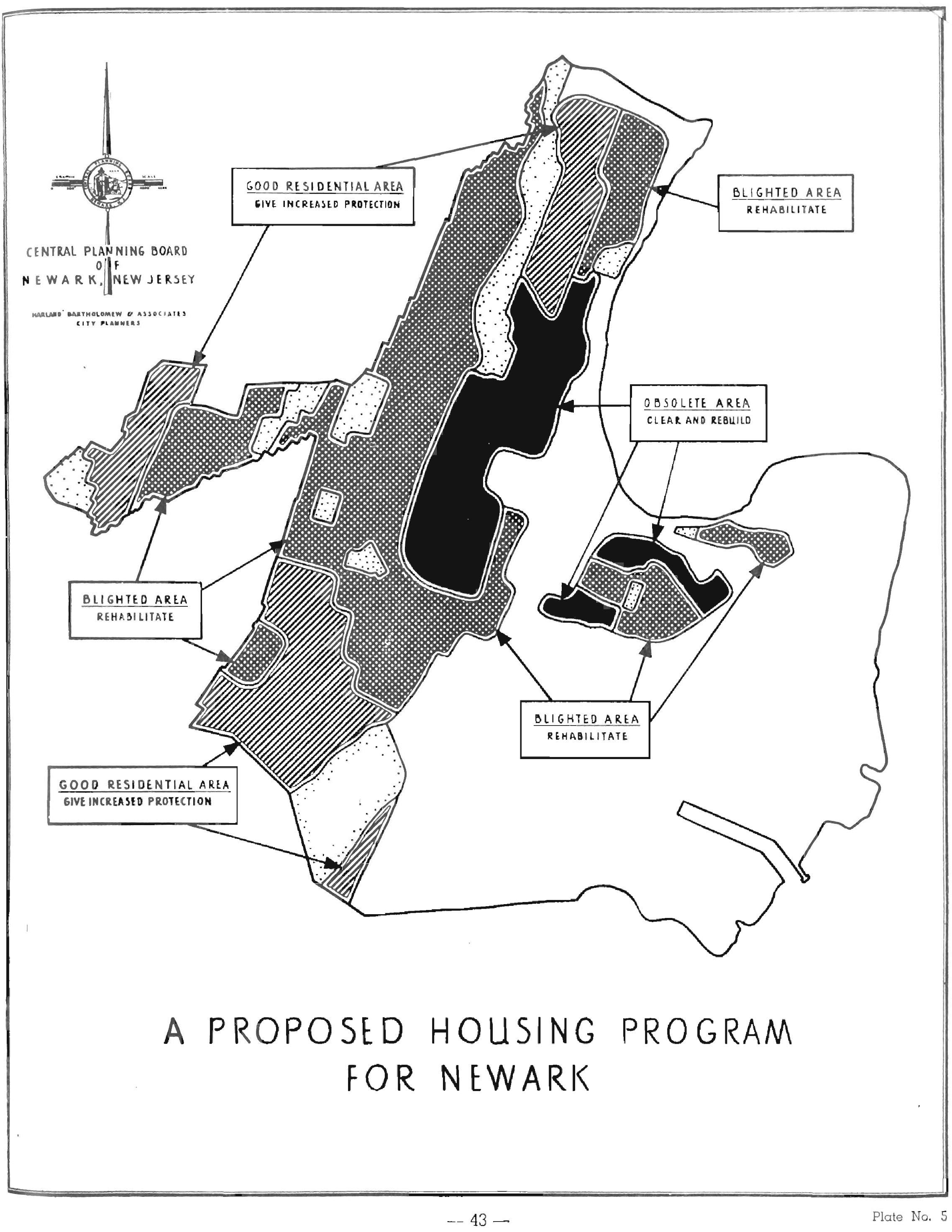
Central Planning Board Newark, New Jersey. (1947). The master plan for the physical development of the City of Newark, N.J. (“A Proposed Housing Program for Newark”) (p. 43, Plate No. 5). City of Newark: Office of Planning, Zoning & Sustainability. Retrieved from https://planitnewark.files.wordpress.com/2011/01/1947newark.pdf
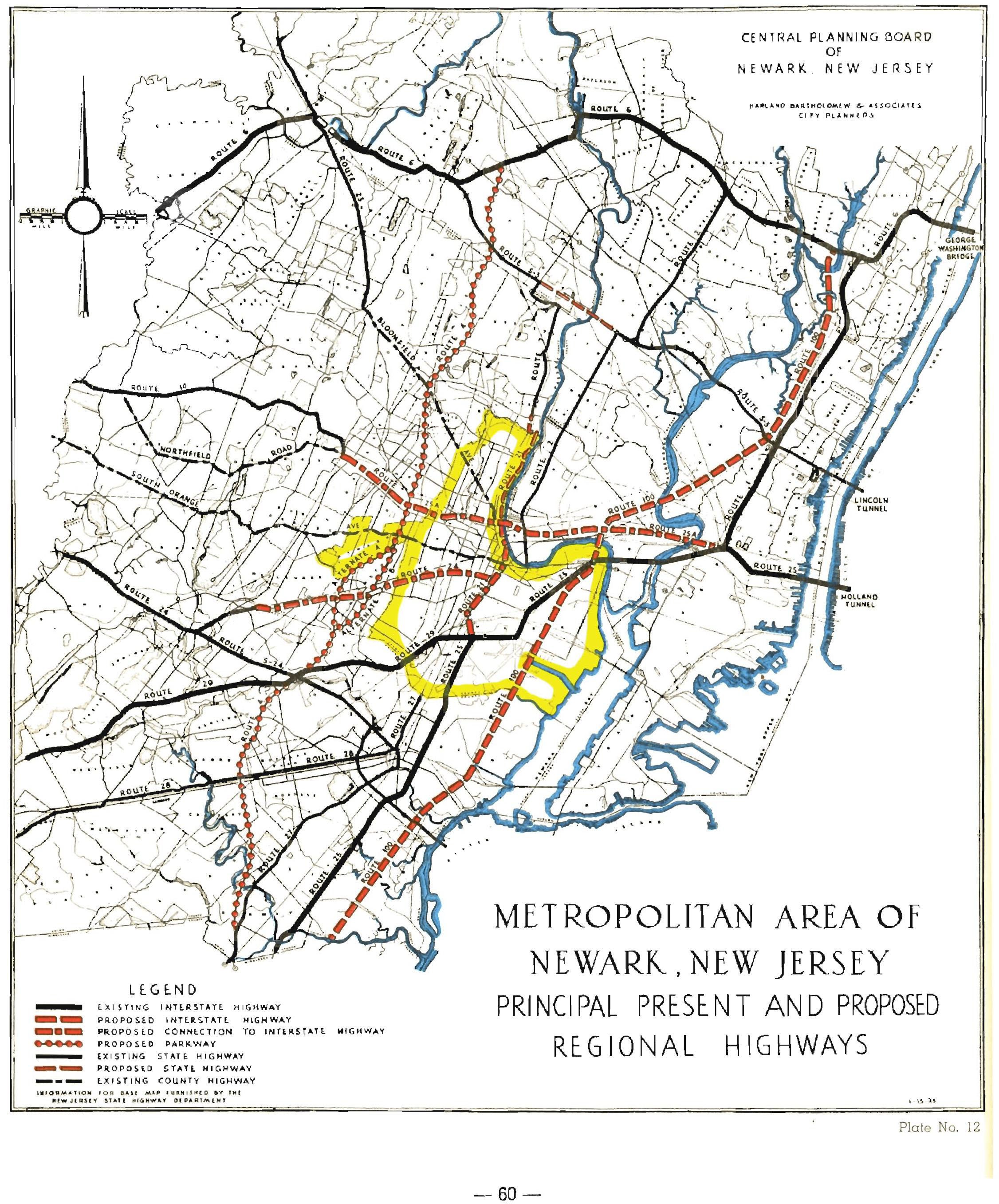
Central Planning Board Newark, New Jersey. (1947). The master plan for the physical development of the City of Newark, N.J. (“Metropolitan Area of Newark, New Jersey: Principal Present and Proposed Regional Highways”) (p. 60, Plate No. 12). City of Newark: Office of Planning, Zoning & Sustainability. Retrieved from https://planitnewark.files.wordpress.com/2011/01/1947newark.pdf
II. 1964, A Core of A Core
Newark’s 1964 Master Plan emphasized its regional location. Adopted February 25, 1965, this revision guided “new highway construction, regional economic changes and population movements.”[1]
The 1964 Plan stressed the New York Metropolitan Region, where Newark is within a designated core radius (of 10 to 15 miles) shared with the Bronx, Brooklyn, Manhattan, Queens and Hudson County, all extending approximately 75 miles from Times Square.[2] Yet, the Division of City Planning states, “while the City of Newark lies within the core of the New York Metropolitan Region, it has long been the center of its own metropolitan area.”[3]
According to the 1964 Plan, Newark at that time was a regional shopping hub, professional and office service center, a key industrial and logistical platform, and the national headquarters for Mutual Benefit and Prudential Life Insurance Companies.[4]
The greater metropolitan regional shift was evident in mid-1963. From this, the City of Newark says, “55-60 per cent of in-city manufacturing jobs are held by persons who are not residents of the City of Newark. This holds true outside of manufacturing as well. In 1960, there were about 136,000 non-manufacturing jobs located within Newark—of these, about 75,000, 55 per cent of the total, were held by other than the city’s residents.”[5]
Population decline continued, falling 8% below the 1930 high. In the 1930s and 1950s, “Newark experienced absolute population declines of 12,000 and 34,000 persons, respectively.”[6]
Heavy out-migration to single-family detached dwellings in the surrounding metropolitan area suburbs continued.[7] In modern times, blight, or urban decay, typically occurs when in close proximity to a larger city. In this 1964 Plan, it is noted that Newark, as its own core, is also within a significantly larger metropolitan core.
After the 1947 Plan, the 1964 Plan placed additional confidence in existing and future urban renewal projects with the expectation that by 1980 the renewal projects would slow Newark’s out-migration and attract new population due to increased housing stock.[8] Even though more population decline was expected for the population outside the renewal areas, an increase in population was anticipated wihtin the renewal areas, implemented after the previous 1947 Plan.[9]
1964 Footnotes:
[1] Division of City Planning and Candueb, Fleissig, Adley & Associates for the Newark Central Planning Board: Newark, N.J. (1964). Master plan 1964 City of Newark N.J. (p. 6). City of Newark: Office of Planning, Zoning & Sustainability. Retrieved from http://cdm16322.contentdm.oclc.org/utils/getfile/collection/p15157coll4/id/50/filename/51.pdf
[2] Division of City Planning. Master plan 1964 City of Newark N.J., op. cit. (p. 11).
[3] Division of City Planning. Master plan 1964 City of Newark N.J., op. cit. (p. 11).
[4] Division of City Planning. Master plan 1964 City of Newark N.J., op. cit. (p. 11).
[5] Division of City Planning. Master plan 1964 City of Newark N.J., op. cit. (p. 13).
[6] Division of City Planning. Master plan 1964 City of Newark N.J., op. cit. (p. 13).
[7] Division of City Planning. Master plan 1964 City of Newark N.J., op. cit. (p. 14).
[8] Division of City Planning. Master plan 1964 City of Newark N.J., op. cit. (p. 15).
[9] Division of City Planning. Master plan 1964 City of Newark N.J., op. cit. (p. 15).
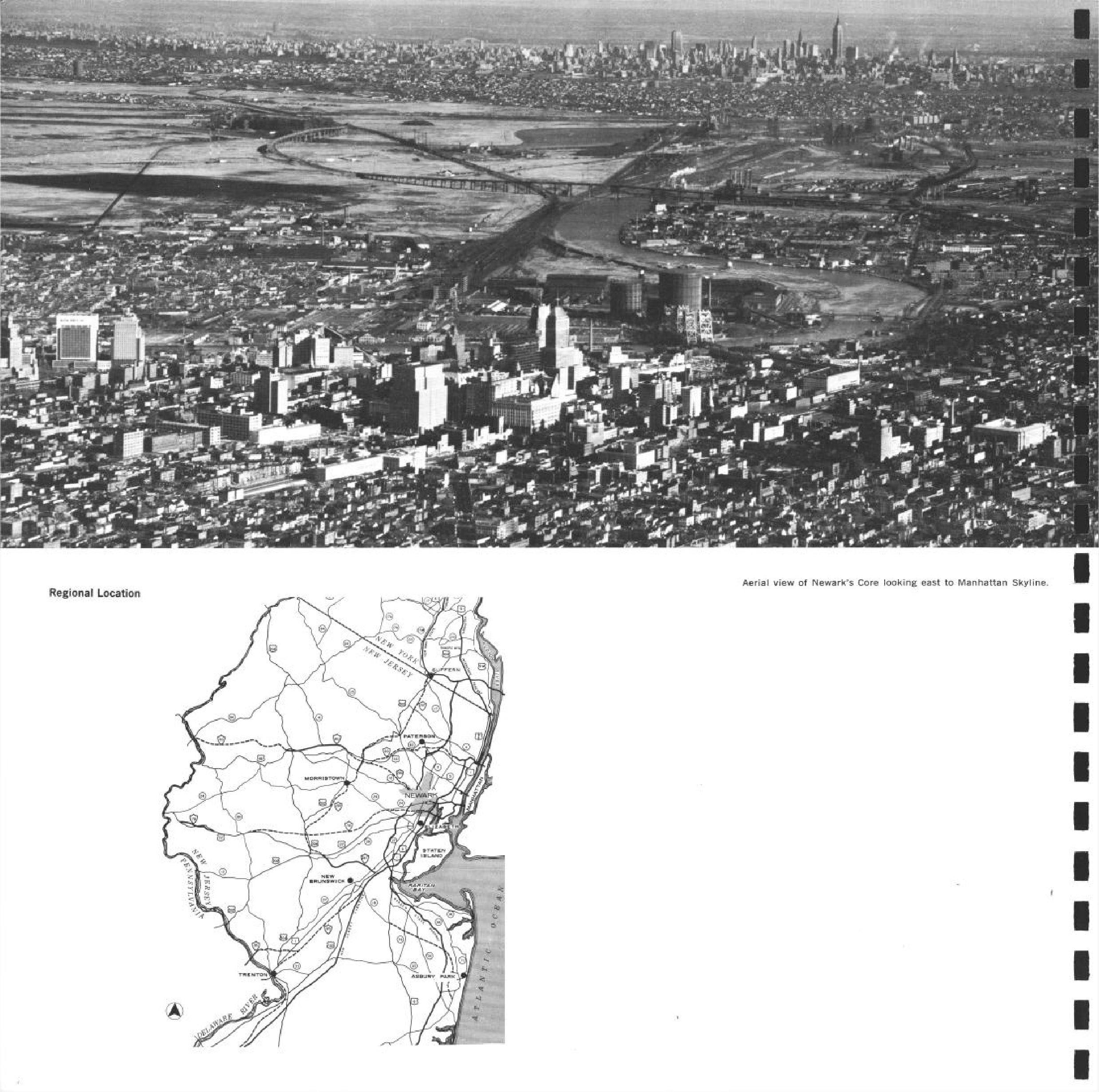
Division of City Planning and Candueb, Fleissig, Adley & Associates for the Newark Central Planning Board: Newark, N.J. (1964). Master plan 1964 City of Newark N.J. (p. 12). City of Newark: Office of Planning, Zoning & Sustainability. Retrieved from http://cdm16322.contentdm.oclc.org/utils/getfile/collection/p15157coll4/id/50/filename/51.pdf
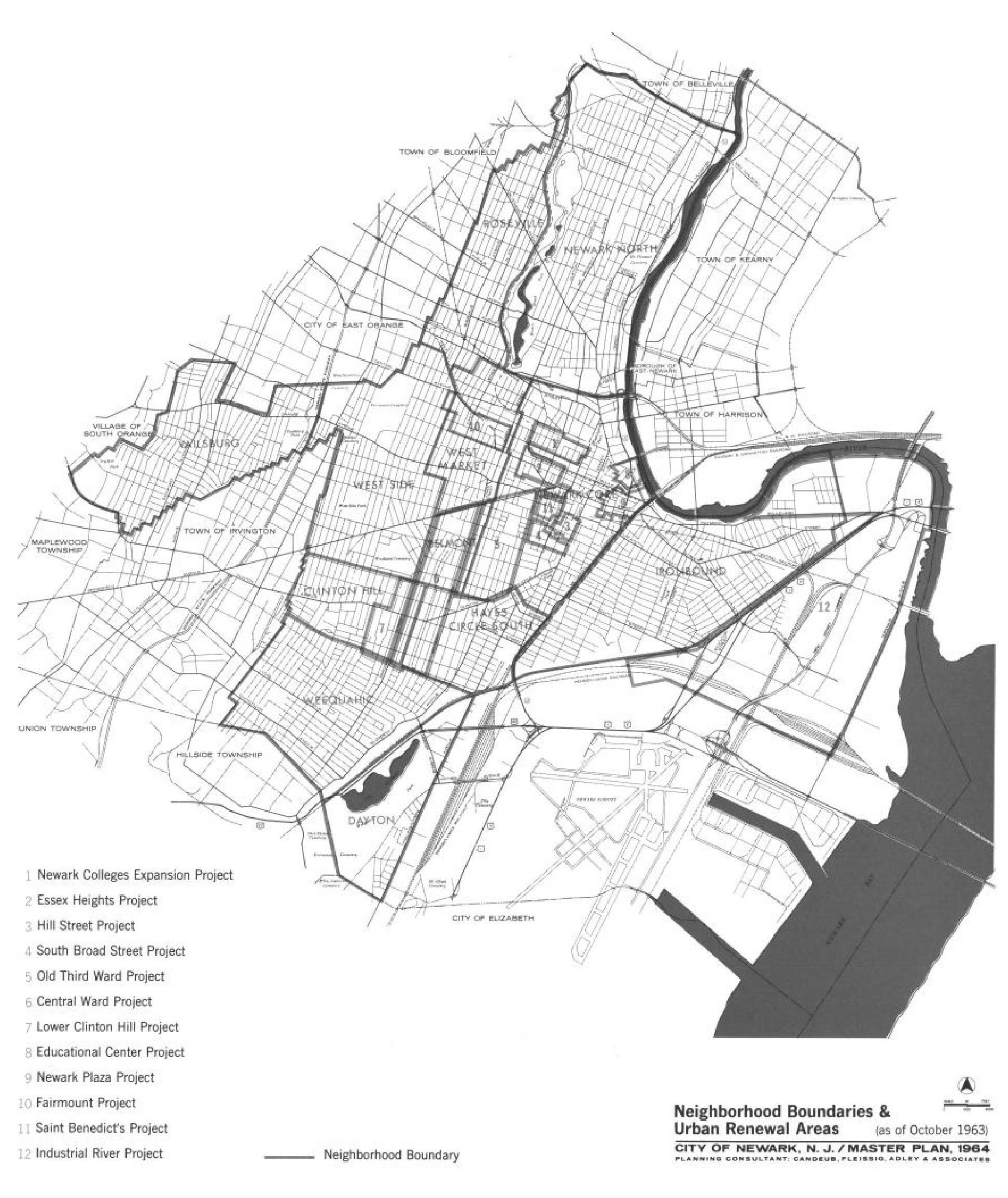
Division of City Planning and Candueb, Fleissig, Adley & Associates for the Newark Central Planning Board: Newark, N.J. (1964). Master plan 1964 City of Newark N.J. (p. 20). City of Newark: Office of Planning, Zoning & Sustainability. Retrieved from http://cdm16322.contentdm.oclc.org/utils/getfile/collection/p15157coll4/id/50/filename/51.pdf
III. 1978, Leave the City
The “Day of Reckoning” came later than 1947. Newark’s 1978 Master Plan says “as residents and private investors leave the City, the local resource base is diminished. During the last seven years the number of properties assessed for tax purposes declined by more than 11% while the property tax rate increased about 16%. However, with additional State and Federal assistance, the City was able to approve a 7.5% reduction in the tax rate for property owners in 1978.”[1]
Further, “since 1971, the number and amount of Government grants awarded to Newark has increased dramatically. In 1971, the City received less than $1 million in restricted Federal funds. By 1976 the amount of restricted Federal grants surpassed $40 million.”[2]
1971 is the historical year of the Nixon Shock that included the end of dollar convertability to gold, meant to tame the domestic problem of inflation. It is the end of Bretton Woods.
1978 Footnotes:
[1] The Mayor’s Policy and Development Office. (1978). Newark master plan. (“Summary”) (p. 2). City of Newark: Office of Planning, Zoning & Sustainability. Retrieved from https://planitnewark.files.wordpress.com/2011/01/1980newarkmasterplan.pdf
[2] The Mayor’s Policy and Development Office. Newark master plan, op. cit. (p. 2).
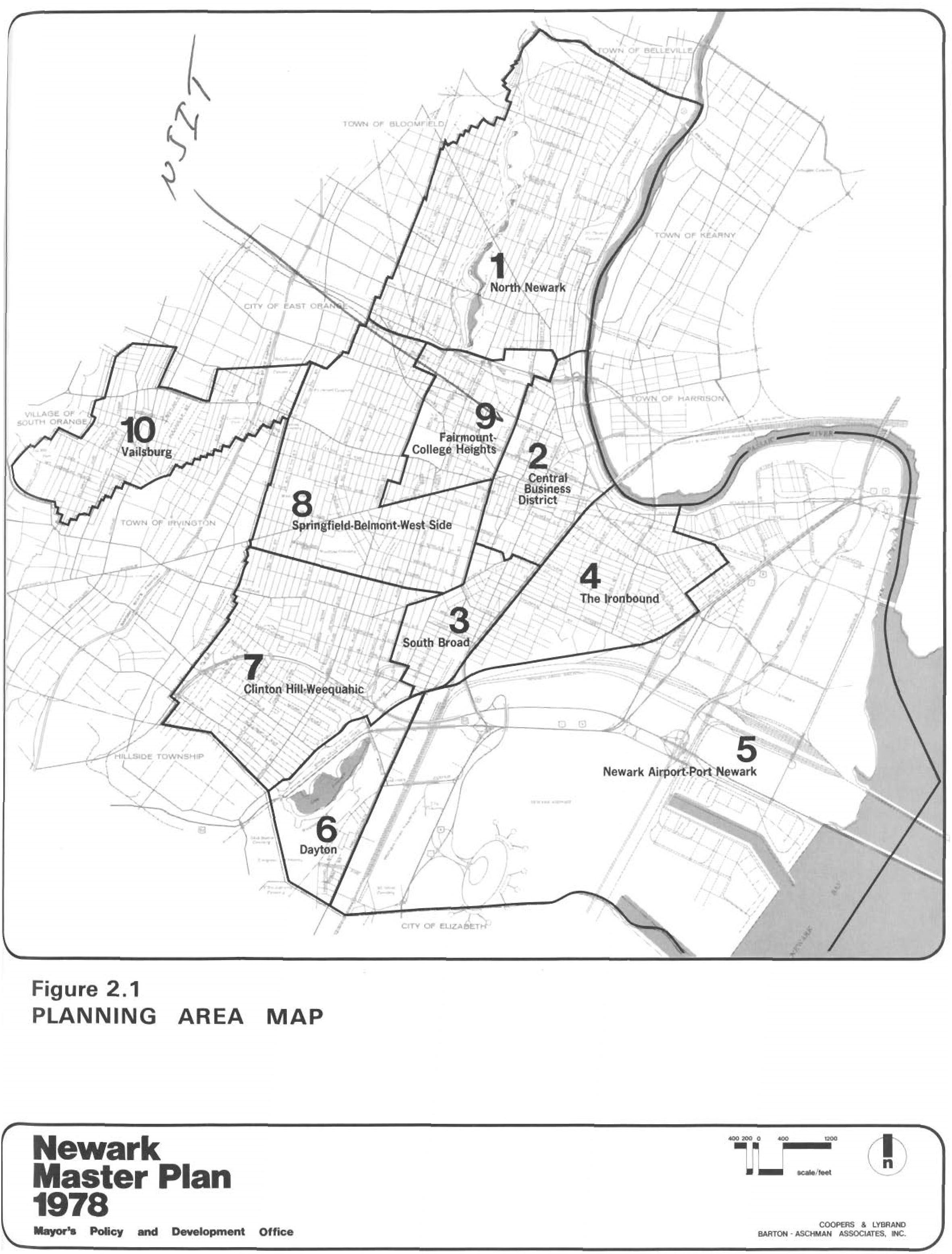
The Mayor’s Policy and Development Office. (1978). Newark master plan. (“Figure 2.1: Planning Area Map”) (p. 2-4). City of Newark: Office of Planning, Zoning & Sustainability. Retrieved from https://planitnewark.files.wordpress.com/2011/01/1980newarkmasterplan.pdf
IV. 2012, Revival
Newark’s 2012 Our City Our Future Plan[1] echoes the 1947 “bold and challenging” sentiment that stated: “Most important of all, it must be a plan of the people and for the people [author’s emphasis]. Otherwise, it is doomed to failure from the beginning.”[2]
The Newark Central Planning Board adopted volumes 1 & 2 of Our City Our Future, on September 24, 2012. The 2012 Plan focuses on how “Newark will set a national standard for urban transformation.”[3] Then Mayor, Cory A. Booker, says “while most municipal plans focus on land use, the emphasis of this plan is on the well-being of our residents,”[4] despite being “prepared to comply with the New Jersey Municipal Land Use Law (MLUL)” for the “major redevelopment plans that apply to certain areas of the city, such as the downtown and riverfront.”[5]
Like the 1947 Plan that found the zoning of the time to be “weak and ineffective,”[6] this 2012 Plan also found a zoning deficiency. Last adopted in the 1950s, the Zoning Ordinance was changed after it was found to be “out of touch with today’s development patterns.”[7]
Some strategies in the City of Newark’s first Economic Development Goal (Economic Stability and Resilience) is to “revive downtown as a regional destination to live, work, shop, and engage in recreation,” and to “recapture Newark’s share of regional retail spending.”[8]
The 2012 Plan took on a participatory role and “systems thinking” approach to address three identified pillars of sustainability that translate into the Policy Goals and Strategies and Actions of economy, equity, and environment.[9] It is here where environment becomes analogous to “A City of Choice,” meaning again, “where a diverse range of people will want to live, work, learn, and play.”[10]
Unlike the 1947 Plan that identified “rapid population increase” as no longer “a reliable measure of progress in a municipality,”[11] in 2012, the City “challenges the entire Newark community to visualize and plan for a city that can and should add at least 50,000 new residents by 2025” (higher than the 22,000 by 2025 estimate of the New Jersey Transportation Planning Authority).[11] The current Plan calculates that “after decades of decline, the Newarker population is growing: over the past 10 years, the city added more than 3,500 residents and 3,100 households. While modest, this growth is dramatic in light of Newark’s experience during the last half of the 20th century—when it lost more than 160,000 residents—and provides strong support for a belief that Newark is poised to significantly rebuild its population in the years ahead.”[12]
Today’s Plan says that in 2010 54% of Newarkers spent more than half of their income on housing (up from 37% in 2000), “meaning they have less money left over to pay for other necessities, such as food, health care, or education.”[13] In the ‘City of Choice’ of today, “more than 140,000 jobs are not actually held by Newarkers.”[14]
In terms of “Neighborhood Identity,” the 2012 Plan highlights that today, “past urban renewal efforts have helped create barriers to public gathering spaces and neighborhood focal points, leaving many residents with a feeling of physical and psychological isolation.”[15] But the vision for a “Neighborhood Identity” in 2025 is a Newark that “capitalizes on existing historic and cultural assets in neighborhoods to create new and improved existing public spaces, facilities, and districts.”[16]
In contrast to Newark’s 1947 Master Plan that designated areas “blighted” or “obsolete,” the 2012 Master Plan’s second mention of “obsolete” does not appear until a reference to a criteria-based, decision-making matrix when questioning whether the City should demolish or preserve a building.[17] Rather than designating “obsolete” directly and overtly to an entire neighborhood, it is instead suggested that “obsolete” designate a single building on a smaller scale.[18]
Also in contrast to both the 1947 and 1964 Plans, the 2012 plan counters the suburbanization process in that all income levels “will increasingly see downtown living as an alternative to the suburbs.”[19] The 1964 emphasis on the regional New York Metropolitan area is now focused on Northern New Jersey and “Newark’s location within a region that contains nearly a third of the nation’s population within a one-day drive (and more than 19 million in the closer New York metropolitan region).”[20]
“Newark’s Downtown Retail Development Strategy” states that “as Newark seeks to grow and establish its downtown as a 24/7 destination for living, working, shopping, and playing, retail expansion is poised to be one of the city’s most effective strategies.”[21]
And yet, “in areas targeted for growth and development, Newark has the capacity to add more than 20,000 new housing units without significantly increasing densities or changing the character of existing residential neighborhoods.”[22] The 2012 Master Plan writes that land use and the physical environment is only a part of Newark’s transformation.
“Well-being” in Newark between today and 2025 may be more about changing people and behaviors.
For example, the 2012 Plan identifies that today “there is also a lack of high quality retail space in the downtown area that would be suitable for national brands and upscale retailers,” and “the residential population in the downtown is small, and the citywide residential population does not have significant disposable income, with only 8% of residents earning over 120% of area median income.”[23]
Two downtown retail development projects in particular, on Halsey Street and Mulberry Street, is where “the City has the opportunity to create a retail strategy that caters to the local markets and eventually leads to a rich retail environment that caputres spending from a diverse group of users.”[24]
The work of Elias[25] is revived when looking at Halsey Street as a hindrance to the City of Newark’s marketing strategy: “while there is already comparatively dense retail along Halsey Street, the quality of this retail is generally substandard,” yet it is “more challenging to transform existing retail character when a set of tenants are already embedded in the area.”[26]
2012 Footnotes:
[1] The Newark Central Planning Board. (2012, September 24). Newark’s master plan: Our city our future (Vol. 1). City of Newark: Office of Planning, Zoning & Sustainability. Retrieved from https://ndex.ci.newark.nj.us/dsweb/Get/Document-515469/econ_MstrPlan_2012_vol2.pdf
[2] Central Planning Board Newark, New Jersey. The master plan for the physical development of the City of Newark, N.J., op. cit. (p. 3).
[3] The Newark Central Planning Board. Newark’s master plan: Our city our future (Vol. 1), op. cit. (p. 3)
[4] The Newark Central Planning Board. Newark’s master plan: Our city our future (Vol. 1), op. cit. (p. 5)
[5] The Newark Central Planning Board. Newark’s master plan: Our city our future (Vol. 1), op. cit. (p. 10)
[6] Central Planning Board Newark, New Jersey. The master plan for the physical development of the City of Newark, N.J., op. cit. (p. 1).
[7] The Newark Central Planning Board. Newark’s master plan: Our city our future (Vol. 1), op. cit. (p. 10)
[8] The Newark Central Planning Board. Newark’s master plan: Our city our future (Vol. 1), op. cit. (p. 18)
[9] The Newark Central Planning Board. Newark’s master plan: Our city our future (Vol. 1), op. cit. (p. 16)
[10] The Newark Central Planning Board. Newark’s master plan: Our city our future (Vol. 1), op. cit. (p. 16)
[11] Central Planning Board Newark, New Jersey. The master plan for the physical development of the City of Newark, N.J., op. cit. (p. 14).
[12] The Newark Central Planning Board. Newark’s master plan: Our city our future (Vol. 1), op. cit. (p. 32)
[13] The Newark Central Planning Board. Newark’s master plan: Our city our future (Vol. 1), op. cit. (p. 22)
[14] The Newark Central Planning Board. Newark’s master plan: Our city our future (Vol. 1), op. cit. (p. 21)
[15] The Newark Central Planning Board. Newark’s master plan: Our city our future (Vol. 1), op. cit. (p. 25)
[16] The Newark Central Planning Board. Newark’s master plan: Our city our future (Vol. 1), op. cit. (p. 25)
[19] The Newark Central Planning Board. Newark’s master plan: Our city our future (Vol. 1), op. cit. (p. 76)
[20] The Newark Central Planning Board. Newark’s master plan: Our city our future (Vol. 1), op. cit. (p. 40)
[21] The Newark Central Planning Board. Newark’s master plan: Our city our future (Vol. 1), op. cit. (p. 60)
[22] The Newark Central Planning Board. Newark’s master plan: Our city our future (Vol. 1), op. cit. (p. 69)
[23] The Newark Central Planning Board. Newark’s master plan: Our city our future (Vol. 1), op. cit. (p. 62)
[24] The Newark Central Planning Board. Newark’s master plan: Our city our future (Vol. 1), op. cit. (p. 62)
[25] Elias, N. The civilizing process, op. cit.
[26] The Newark Central Planning Board. Newark’s master plan: Our city our future (Vol. 1), op. cit. (p. 62)
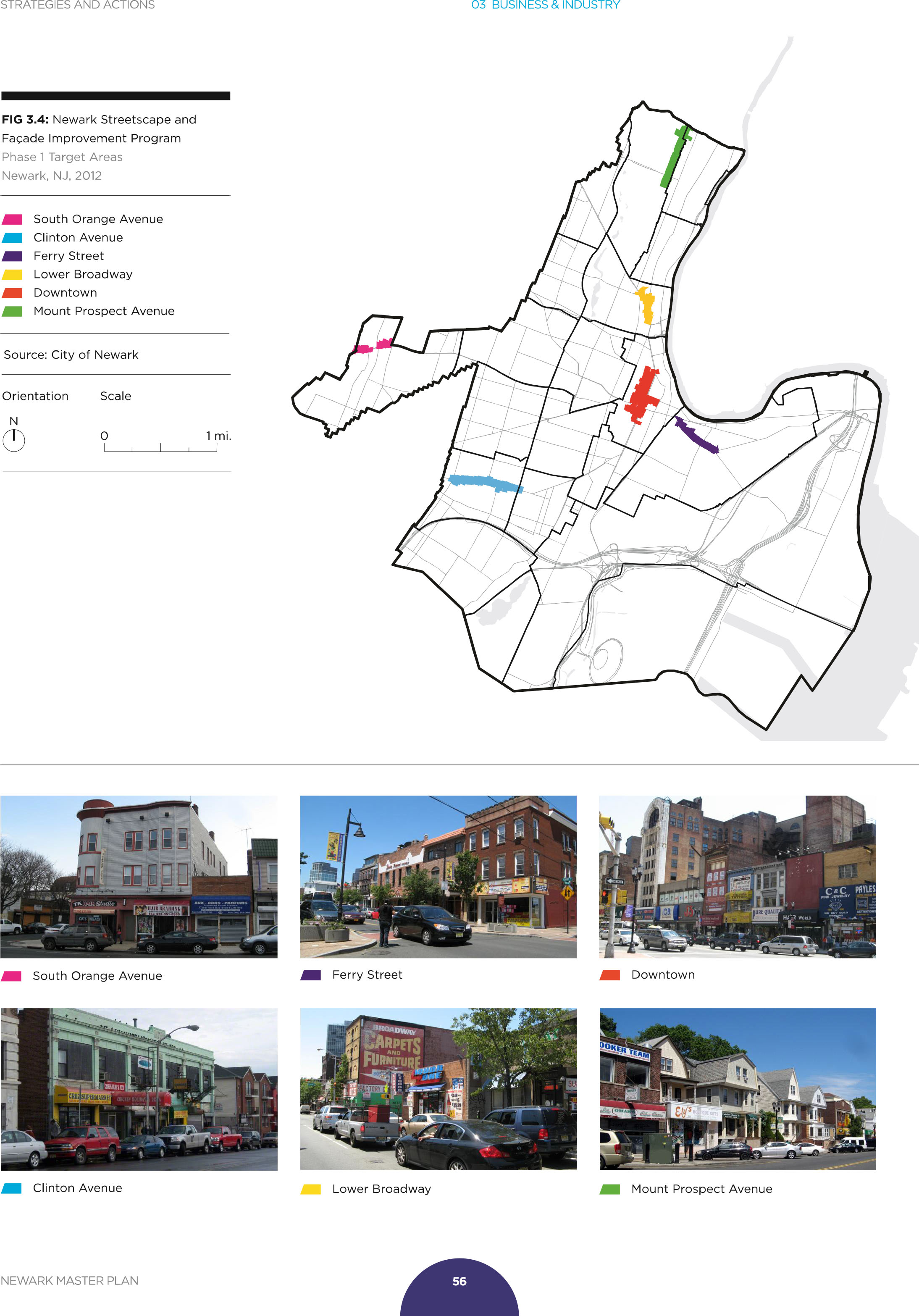
The Newark Central Planning Board. (2012, September 24). Newark’s master plan: Our city our future (Vol. 1). (“Strategies and Actions: Business & Industry”) (p. 56). City of Newark: Office of Planning, Zoning & Sustainability. Retrieved from https://ndex.ci.newark.nj.us/dsweb/Get/Document-515469/econ_MstrPlan_2012_vol2.pdf
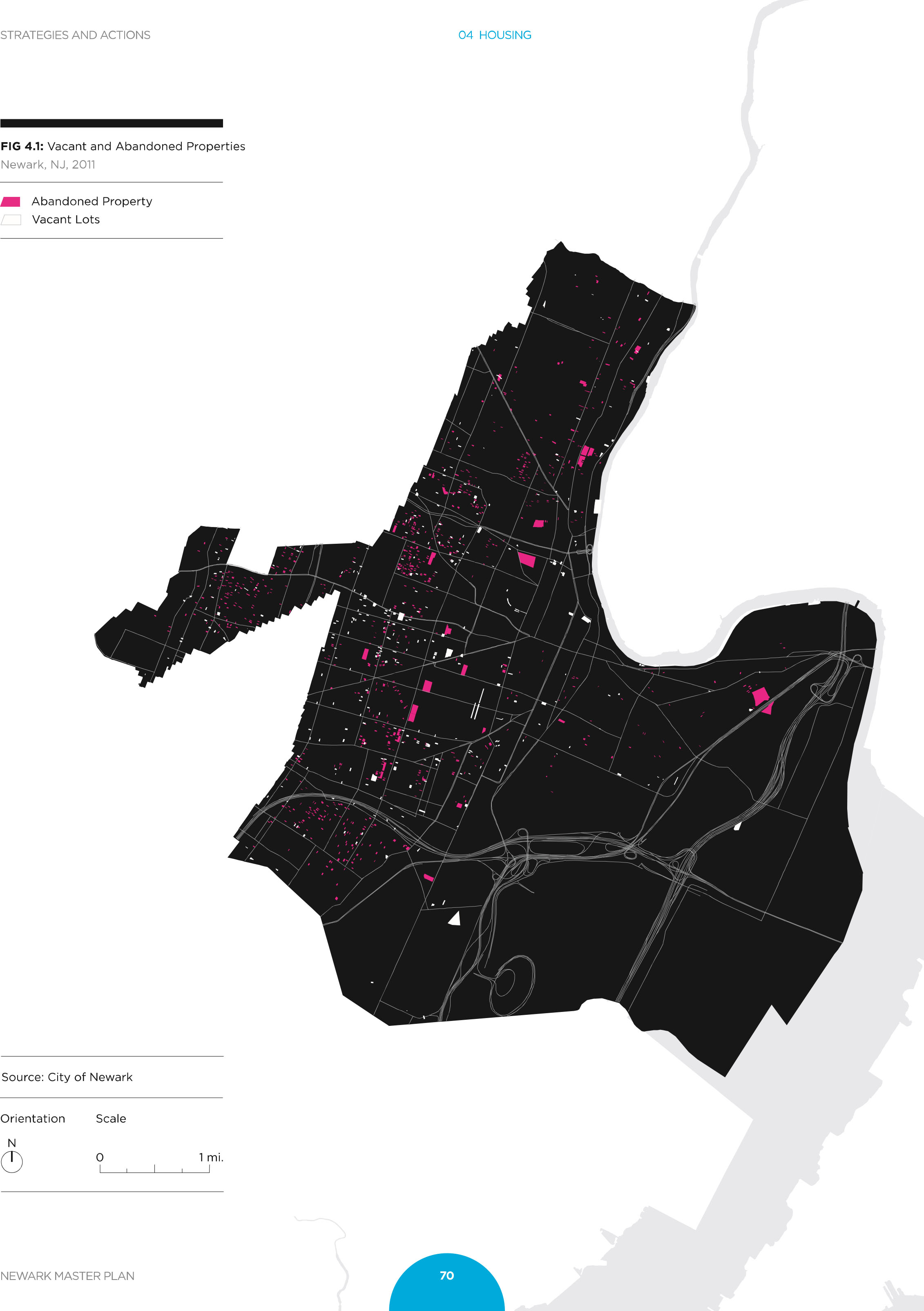
[ii] The Newark Central Planning Board. (2012, September 24). Newark’s master plan: Our city our future (Vol. 1). (“Strategies and Actions: Housing”) (p. 70). City of Newark: Office of Planning, Zoning & Sustainability. Retrieved from https://ndex.ci.newark.nj.us/dsweb/Get/Document-515469/econ_MstrPlan_2012_vol2.pdf
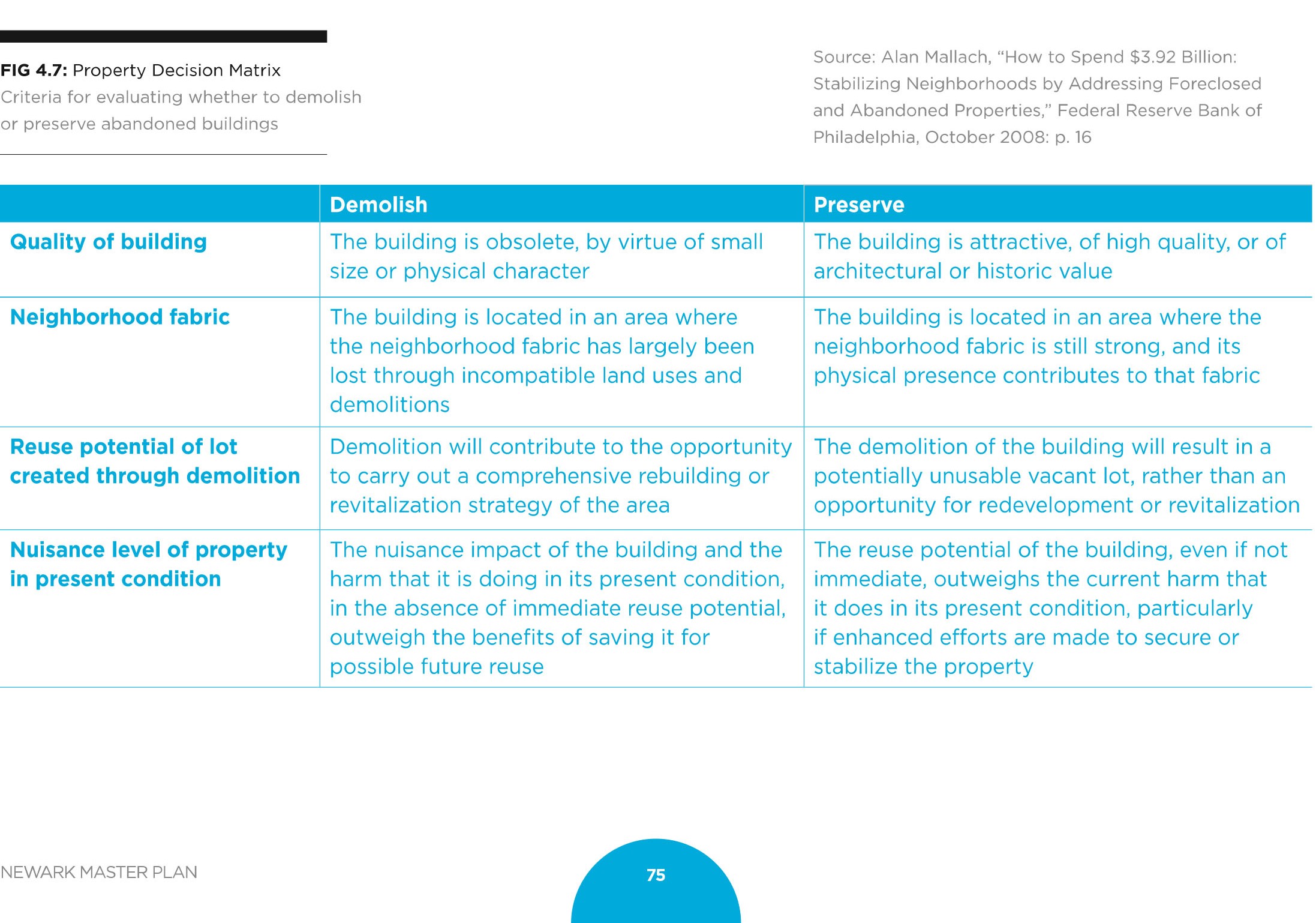
The Newark Central Planning Board. (2012, September 24). Newark’s master plan: Our city our future (Vol. 1). (“Fig 4.7: Property Decision Matrix”) (p. 75). City of Newark: Office of Planning, Zoning & Sustainability. Retrieved from https://ndex.ci.newark.nj.us/dsweb/Get/Document-515469/econ_MstrPlan_2012_vol2.pdf
Newark—on Heterogenesis of Urban Decay by Sara Bissen